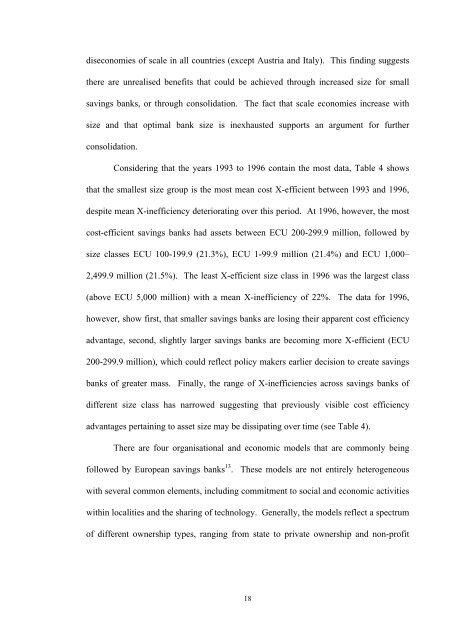Efficiency in Banking: Empirical Evidence from the Savings ... - Ivie
You also want an ePaper? Increase the reach of your titles
YUMPU automatically turns print PDFs into web optimized ePapers that Google loves.
diseconomies of scale <strong>in</strong> all countries (except Austria and Italy). This f<strong>in</strong>d<strong>in</strong>g suggests<br />
<strong>the</strong>re are unrealised benefits that could be achieved through <strong>in</strong>creased size for small<br />
sav<strong>in</strong>gs banks, or through consolidation. The fact that scale economies <strong>in</strong>crease with<br />
size and that optimal bank size is <strong>in</strong>exhausted supports an argument for fur<strong>the</strong>r<br />
consolidation.<br />
Consider<strong>in</strong>g that <strong>the</strong> years 1993 to 1996 conta<strong>in</strong> <strong>the</strong> most data, Table 4 shows<br />
that <strong>the</strong> smallest size group is <strong>the</strong> most mean cost X-efficient between 1993 and 1996,<br />
despite mean X-<strong>in</strong>efficiency deteriorat<strong>in</strong>g over this period. At 1996, however, <strong>the</strong> most<br />
cost-efficient sav<strong>in</strong>gs banks had assets between ECU 200-299.9 million, followed by<br />
size classes ECU 100-199.9 (21.3%), ECU 1-99.9 million (21.4%) and ECU 1,000–<br />
2,499.9 million (21.5%). The least X-efficient size class <strong>in</strong> 1996 was <strong>the</strong> largest class<br />
(above ECU 5,000 million) with a mean X-<strong>in</strong>efficiency of 22%. The data for 1996,<br />
however, show first, that smaller sav<strong>in</strong>gs banks are los<strong>in</strong>g <strong>the</strong>ir apparent cost efficiency<br />
advantage, second, slightly larger sav<strong>in</strong>gs banks are becom<strong>in</strong>g more X-efficient (ECU<br />
200-299.9 million), which could reflect policy makers earlier decision to create sav<strong>in</strong>gs<br />
banks of greater mass. F<strong>in</strong>ally, <strong>the</strong> range of X-<strong>in</strong>efficiencies across sav<strong>in</strong>gs banks of<br />
different size class has narrowed suggest<strong>in</strong>g that previously visible cost efficiency<br />
advantages perta<strong>in</strong><strong>in</strong>g to asset size may be dissipat<strong>in</strong>g over time (see Table 4).<br />
There are four organisational and economic models that are commonly be<strong>in</strong>g<br />
followed by European sav<strong>in</strong>gs banks 13 . These models are not entirely heterogeneous<br />
with several common elements, <strong>in</strong>clud<strong>in</strong>g commitment to social and economic activities<br />
with<strong>in</strong> localities and <strong>the</strong> shar<strong>in</strong>g of technology. Generally, <strong>the</strong> models reflect a spectrum<br />
of different ownership types, rang<strong>in</strong>g <strong>from</strong> state to private ownership and non-profit<br />
18
















